Guide
Local Business Site Strcuture

by Tom Richards - Lead SEO & Director
In today’s digital world, having a strong online presence is crucial for the success of your local business. However, many business owners are unaware of the impact that website structure can have on their SEO efforts.
Table of Contents
In this guide, we will explain the importance of site structure and how it can benefit your business.
What is Site Structure?
Site structure, also known as site architecture, refers to how the content on your website is organized. It involves structuring and linking different pages together to make it easier for users to navigate and find the information they need. A well-structured site not only improves user experience but also enhances your visibility in search engine results.
Why is a Good Site Structure Important?
A well-structured website is crucial for the growth of your local business, and here’s why:
Improved User Experience: A good site structure ensures that your website is user-friendly and easy to navigate. This leads to a positive user experience, which is essential for attracting and retaining visitors. Studies show that a large percentage of people will leave a website if it has a poor layout or unattractive content. By organizing your site effectively, you can engage users and keep them interested in what you offer.
Increased Traffic and Performance: When your site is organized and easy to navigate, it becomes more appealing to both users and search engines. A well-structured website attracts more traffic, as users can quickly find the information they are looking for. Additionally, search engines rely on your site’s structure to understand its content and index it properly. By optimizing your site’s structure, you can improve your rankings in search engine results and drive more organic traffic to your business.
Seamless SEO Integration: Site structure plays a central role in any effective SEO strategy. By building your website’s structure with SEO in mind from the beginning, you save yourself from the hassle of later trying to optimize or rebuild it to make it search engine friendly. A solid site structure helps search engine crawlers navigate and index your web pages more efficiently, resulting in improved visibility and higher rankings.
Essential Components of Website Structure
When it comes to determining your website’s architecture, there are several essential components that you should focus on:
Main Menus: The main menu of your website consists of links that allow users to navigate between different pages or sections of your site easily.
Sub Menus: If you have a larger website with more elements, adding sub menus can help you better organize and categorize your content.
Internal Links: Internal links are links that connect one page on your website to another page or resource within the same site. They establish an information hierarchy and improve navigation.
Services Pages: Each service your business offers should have its own dedicated page. This makes it easier for both users and search engines to understand what services you provide.
Location Pages: If your business has multiple locations, it is crucial to create a page on your website where you can list all your locations. This helps users find the nearest location to them.
About Page: The about page should provide visitors with a clear understanding of what your business does and what it has to offer.
Contact Page: The contact page should include information about how visitors can get in touch with your business through various communication channels.
Privacy Policy: Your website should have a privacy policy page that is easily accessible in the footer or a designated section. This page informs visitors about how their data is collected and used.
Plan Before Building Your Website
When starting a website from scratch, take the opportunity to build a structure that will support your SEO efforts. Before diving into creating your site’s pages, it is crucial to plan carefully. Here are the steps you should follow to create a proper structure for your local business website:
List all Pages: Start by listing out all the pages that you want to include on your site. This may include services, locations, contact information, and other essential pages.
Define Target Pages: Identify the pages that you want to prioritize for your local SEO campaign. These are the pages where you want visitors to land, and you will focus your SEO efforts on optimizing them. It could be your home page, service page, location page, or any other page that is crucial for attracting potential customers to your local business.
By optimizing these target pages with relevant keywords and focusing on geo-targeting, you can drive the majority of your website’s traffic and improve your local search visibility.
Deciding Target Pages
Deciding which pages on your website to target for specific keywords depends on various factors. For a single-location business, it is recommended to optimize the home page for the main keyword and location, such as “Plumber Eastern Suburbs.” This approach allows the home page to rank well for relevant searches.
However, if your business has multiple locations, you have a few options. You can target the home page for the most competitive keyword, such as “Plumber Sydney” or “Accountant Sydney,” and create inner pages for other locations. Alternatively, you can keep the home page branded and create separate inner pages optimized for the main keywords and specific locations.
There is no definitive right or wrong answer, and the approach may vary based on your business’s specific circumstances. The goal is to strategically optimize your website’s pages to target relevant keywords and locations to enhance your online visibility and attract potential customers.
City Tax Accountants:
If we use the website City Tax Accountants in Sydney as an example, we can see they have used the home page to target their main keyword “Tax Return Sydney”.
Using your home page to target the main keyword or the highest searched keyword comes with a host of benefits.
The main benefit is that the home page naturally gets the majority of the backlinks and becomes your website’s most powerful page.

Fixed Today Plumbing:
However, if we take a look at another example from Fixed Today, which is a Sydney-based plumbing site, they have taken a different approach. They have kept their home page branded with more informational content and they’ve created an inner page targeting their main keyword “Plumber Sydney”, heavily optimising it for “Sydney” based keywords.
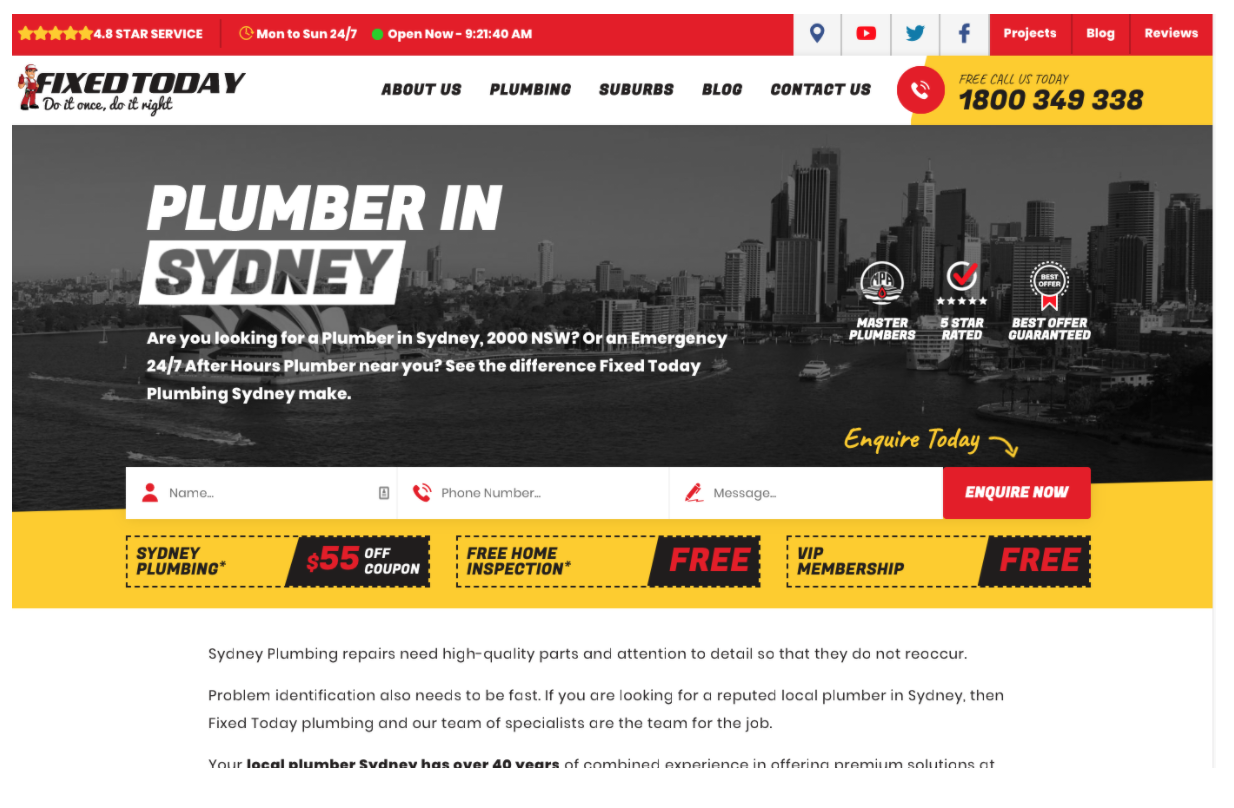
There is no definitive right or wrong answer, and the approach may vary based on your business’s specific circumstances. The goal is to strategically optimize your website’s pages to target relevant keywords and locations to enhance your online visibility and attract potential customers.
URL Structure & Hierarchy
After determining your target pages, the next important step is to establish the URL structure for your website. Creating a navigation hierarchy is crucial, as it organizes the information on your site in a logical manner. The URL structure will follow this hierarchy, forming the foundation of your website.
Using the plumbing example, you can create a spreadsheet or flow diagram to outline all the pages of your site. This list will not only assist in building your website’s menu but can also serve as the menu itself if your site is not too large. This organized approach helps in creating an intuitive and user-friendly website structure.

There are several options when it comes to organizing the serviced areas and suburb pages.
Option 1: You can keep the serviced areas pages “Eastern Suburbs” and “Inner West” as top-level pages, and interlink the suburbs pages.
The URLs will look like this:
- plumbingexample.com.au/plumber-eastern-suburbs/
- plumbingexample.com.au/plumber-randwick/
- plumbingexample.com.au/plumber-bondi/
This is the structure that Sydney’s Plumbing Specialists have chosen for their site.
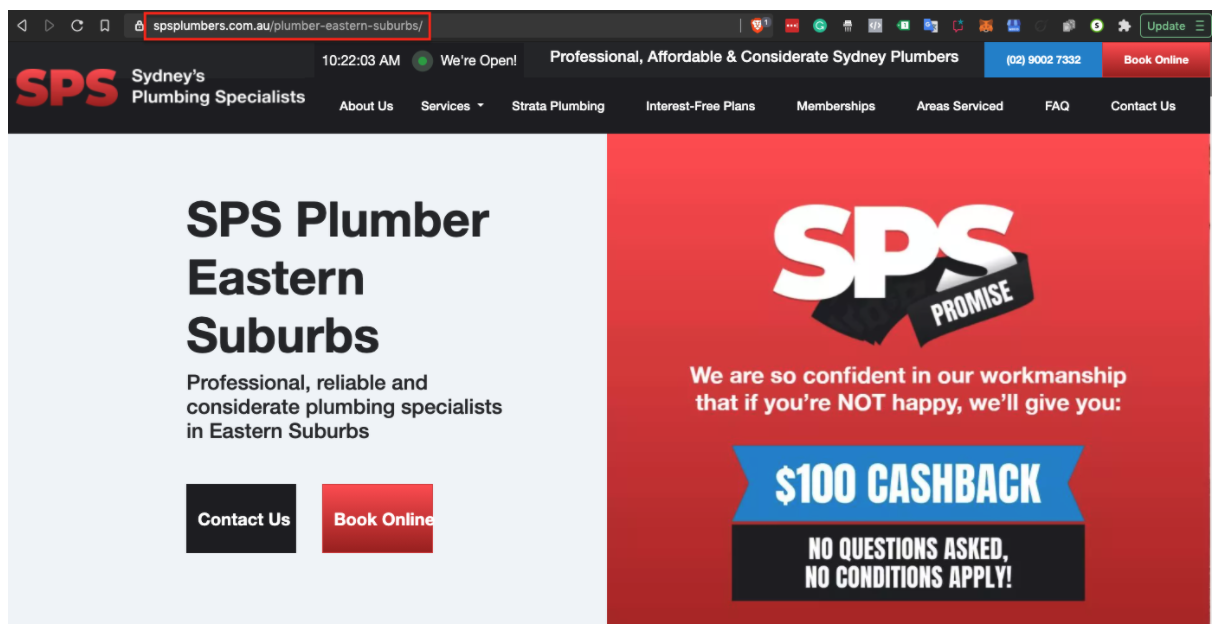
Option 2: You can have the suburb pages as subpages of the /serviced-area/ page.
The URLs will look like this:
- plumbingexample.com.au/serviced-areas/plumber-bondi/
- plumbingexample.com.au/serviced-areas/plumber-randwick/
plumbingexample.com.au/serviced-areas/plumber-coogee/
This is also how Fixed Today have structured their site.
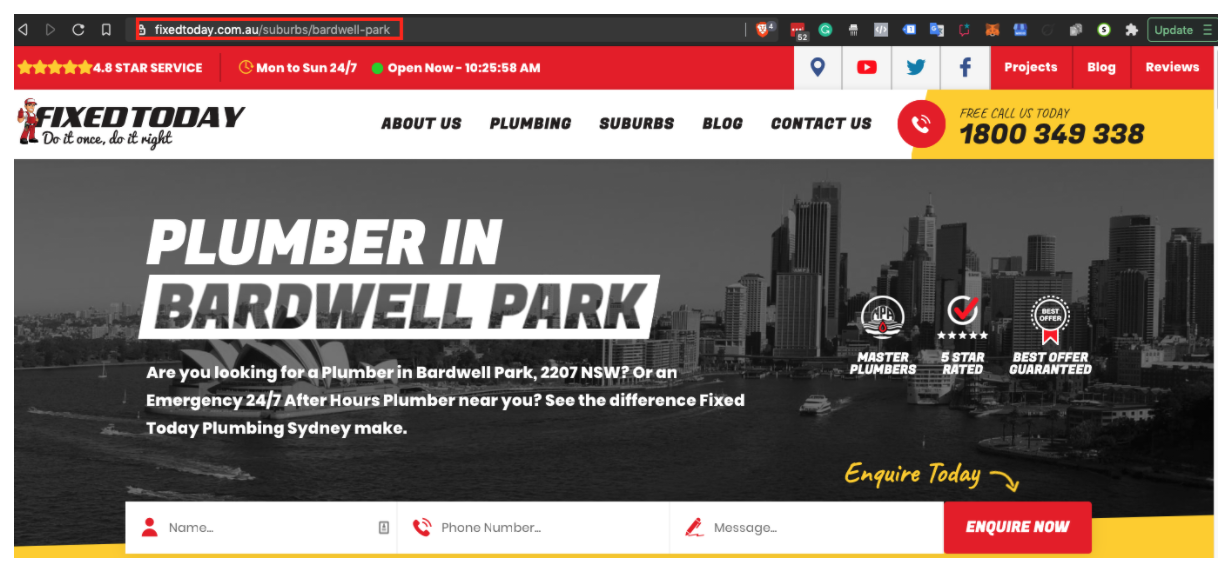
Once again, there’s no right or wrong way to do this. Performance wise, both of these sites are ranking really well and they are both bringing in around 50,000USD of traffic per month through SEO, as shown by Ahrefs’ SEO metrics below.
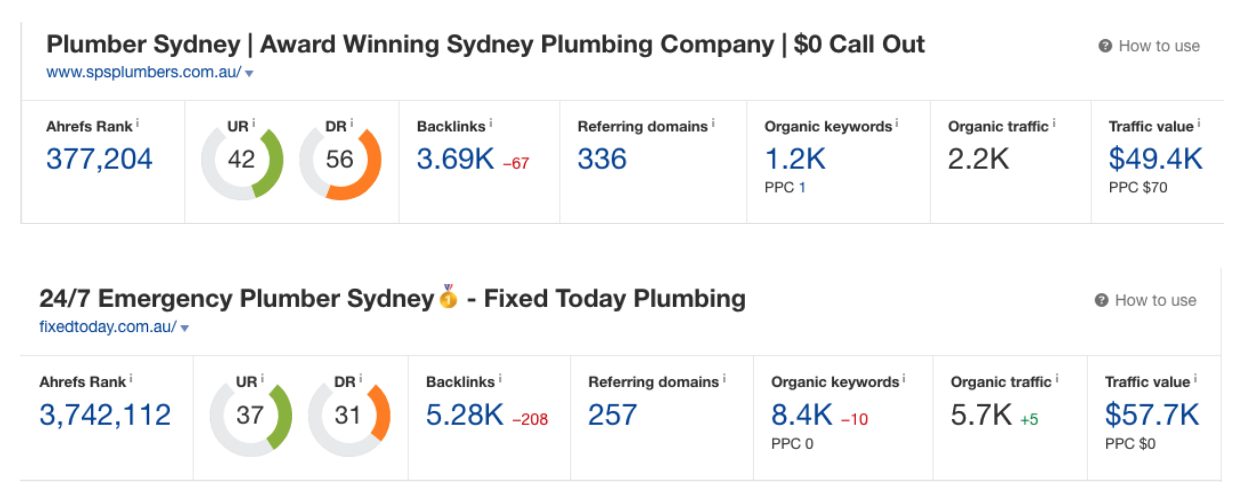
Internal Linking Structure
Last but not least, you have to develop an internal linking structure.
What are internal links?
Just as we’ve mentioned previously, internal links refer to links that go from one page on a website to a different page on the same website. According to SEO best practices, all the pages on a website should have links to and from different pages on the same website.
Why is internal linking structure important?
There are three main reasons why developing an internal linking structure is important for your website, and we’re going to list them all here.
- They help users navigate your website and find what they need with ease – keep your visitors happy by ensuring a smooth user experience and they’ll spend more time on your pages, which in turn will also contribute to boosting your site’s rankings.
- They connect your website’s content and help establish information hierarchy – this helps search engines understand your site’s structure, what your pages are about and which pages are the most important, so you can improve visibility for them.
- They ensure link equity around your website – if you want all your pages to rank well, creating a comprehensive linking structure can help you with that by passing authority and value from one page to another.
Creating the Internal Link Plan
Most of the work has been completed in the previous steps and we can now take that and build off it.
We want to make sure that:
- All pages are linking back to the home page
- All services pages link back to the service page
- Suburbs pages link back to the area pages
- Area pages link back to the home page
- All blog posts interlink with each other and with other relevant pages
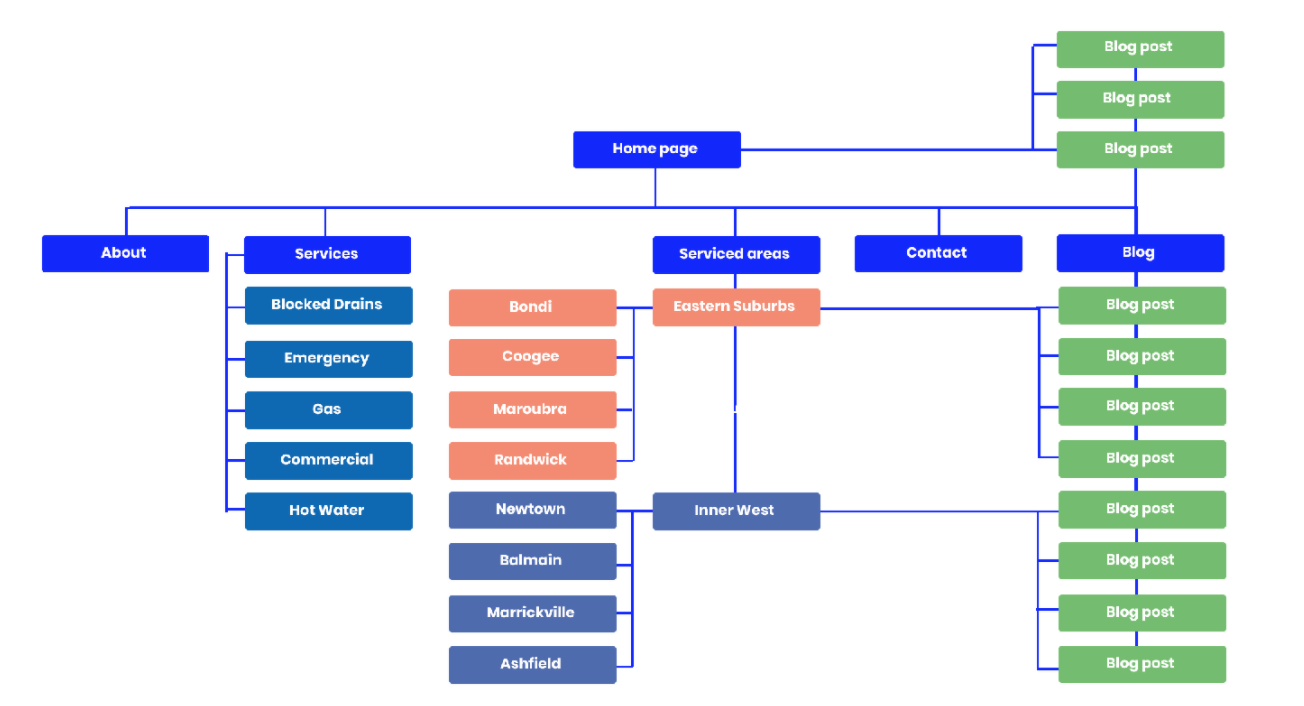
If you want to build a great website for your local business that can set you on the path to success, starting with a proper website structure is of the utmost importance. You have to plan your site structure carefully, ideally before you’ve built your site. But if you already have a business website, you can still work on its structure and improve its performance SEO wise.
Site structure is one of the most important aspects to consider when optimizing a website for search engines, but one that is very often ignored by many business owners. Building, maintaining and improving your site’s structure is at the core of any successful SEO strategy.


